Pickled herring
It has been suggested that Schmaltz herring be merged into this article. (Discuss) Proposed since November 2013. |


Pickled herring, also known as bismarck herring,[1] is a delicacy in Europe, and has become a part of Baltic, Nordic, Dutch, German (Bismarckhering), Czech (zavináč), Polish (śledzie), Eastern Slavic, Scottish and Jewish cuisine.
Most cured herring uses a two-step curing process. Initially, herring is cured with salt to extract water. The second stage involves removing the salt and adding flavorings, typically a vinegar, salt, sugar solution to which ingredients such as peppercorn, bay leaves and raw onions are added. In recent years, other flavors have also been added, due to foreign influences. However, the tradition is strong in Denmark, Sweden, Finland, Norway, The Netherlands, Iceland and Germany. Onion, sherry, mustard and dill are some of the traditional flavourings.
History
Pickled herrings have been a staple in Northern Europe since Medieval times, being a way to store and transport fish, especially necessary in meatless periods like Lent. The herrings would be prepared, then packed in barrels for storage or transportation.
Geographic distribution
In the Nordic countries, once the pickling process is finished and depending on which of the dozens of classic herring flavourings (mustard, onion, garlic, lingonberries etc.) are selected, it is eaten with dark rye bread, crisp bread, sour cream, or potatoes. This dish is common at Christmas, Easter and Midsummer, where it is frequently eaten with akvavit. Often, it is incorporated in a Fischbrötchen.
In the 19th century, people in Berlin developed a special treat known in English as soused herring or rollmops.[2][3] Rollmops are pickled herring fillets rolled (hence the name) into a cylindrical shape around a piece of pickled gherkin or an onion. The word is borrowed from the German.
Pickled herring, especially brined herring, is common in Russia and Ukraine, where it is served cut into pieces and seasoned with sunflower oil and onions, or can be part of herring salads, such as dressed herring, which are usually prepared with vegetables and seasoned with mayonnaise dressing.
Brined herring is common in Ashkenazi Jewish cuisine, perhaps best known for forshmak salad known in English simply as "chopped herring" and as schmaltz herring in Yiddish.
Pickled herring can also be found in the cuisine of Hokkaidō in Japan, where families traditionally preserved large quantities for winter.
In Nova Scotia, a province of Canada, pickled herring is called "solomun gundy" and is quite popular. Not to be confused with the Jamaican term for a pickled fish pâté.
Health effects
It is rich in tyramine and thus should be avoided in the diet of people being treated with an antidepressant monoamine oxidase inhibitor.[4]
Pickled herring is one of the best sources of natural vitamin D3, it is also an excellent source of selenium and vitamin B12. 100 gram may provide 680 IU of vitamin D or 170% of the DV, as well as 84% of the DV for selenium and 71% of the DV for vitamin B12. [5][6]
Cultural references
Pickled herring is one of the twelve dishes served at Christmas Eve in Poland and in Ukraine.
See also
Notes
- ^ Dictionary.com - Bismarck herring
- ^ Erich Urban, Das Alphabet der Küche, Berlin 1929, Artikel Rollmops, S. 201
- ^ Duden-Eintrag
- ^ Brown CS and Bryant SG (1988) "Monoamine oxidase inhibitors: safety and efficacy issues" Drug Intell Clin Pharm, 22 (3): 232–235.
- ^ http://nutritiondata.self.com/facts/finfish-and-shellfish-products/4067/2
- ^ http://nutritiondata.self.com/foods-000102000000000000000.html
References
- Froese, Rainer; Pauly, Daniel (eds.). "Species in genus Clupea". FishBase. January 2006 version.
- O'Clair, Rita M. and O'Clair, Charles E., "Pacific herring," Southeast Alaska's Rocky Shores: Animals. pg. 343-346. Plant Press: Auke Bay, Alaska (1998). ISBN 0-9664245-0-6


